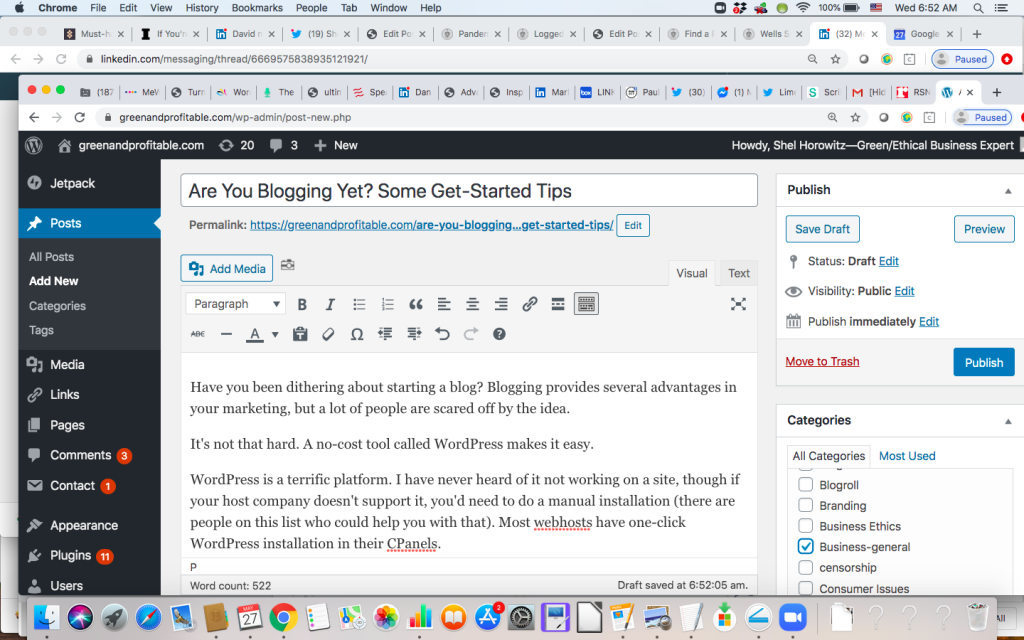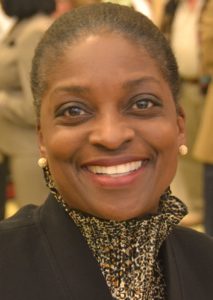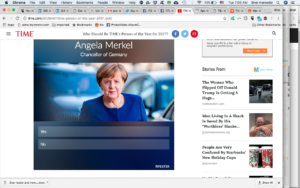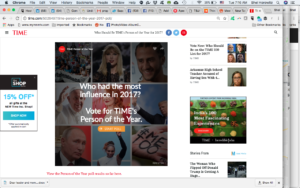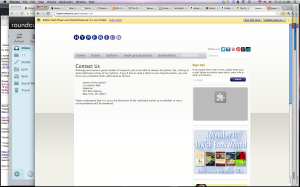These are my rough notes from Podcamp Western Mass 5, held March 30, 2013 at Holyoke Community College. It uses abbreviations: SM = social media; the others are pretty obvious. If I spelled your name wrong, I apologize.
According to organizer Morriss Partee, @mmpartee, since the Boston folks did a big regional thing several hundred miles south, this is now the longest continuously running Podcamp in New England.
I took notes on every session I attended except my own session, “Making Green Sexy.” I would be happy to send the slides from my talk; simply e-mail shel at greenandprofitable.com or Tweet @ShelHorowitz with the message “Podcamp PPT” (if tweeting, be sure to include your e-mail).
BUILDING OFFLINE RELATIONSHIPS FROM ONLINE CONNECTIONS
Thomas J. Fox, former addict, financial literacy/econ devel, lots of speaking:
I started in SM as the Pajama Poet on MySpace! Became the top poet there.
Social media eliminates the gatekeeper. I get an invitation to sit in on a financial literacy conference at the White House, b/c Twitter. Ask questions of important people, start conversations, build on conversations get known by them—get immersive. But it can’t be about you you you—be genuine. You build the relationship organically.
And then you take the relationship OFFline. I had a coffee with a guy I met on Twitter and I connected him to 10 people in the community. When you meet, you already know what you have in common. It goes right to how to help each other. You’re catching up with an old friend.
Listen 100% to what someone is saying.
Not interacting on SM is like having a drawer full of business cards.
Work/exercise your networking muscle, and remember you’re a brand.
Vine: new platform, 6-second videos!
Foursquare can build your brand. If you login from PV Planning Commission, Develop Springfield, etc., networking events, it shows you’re serious. And every time I’m speaking, publish an article, I post on SM. People see I’m serious and I’m genuine. At networking events, I focus on the coordinators, and they know everyone else.
And if I’m traveling to speak, I make time to meet SM contacts in Denver or wherever. And it can be huge for business.
Promote others.
For three years, I’ve been trying to meet Harold Grinspoon. I met a janitor who works for him, and he introduced me. Just because you don’t think someone can help you… I’ll have coffee with anyone. You never know.
Audience: people who built their personal networks BEFORE they needed them were much more effective. This predates the web, but online makes it faster and easier.
I’m doIng everything I do right now b/c one person invested time in me. Otherwise, I’d be dead in a ditch somewhere. I work w/ Junior Achievement to create economic opp for young kids. It takes a village to sustain an economy. Get involved in SOMETHING: friends of the homeless, whatever.
SOCIAL MEDIA FOR ACTIVISM (open panel)
Cool apps:
ittt: If then then that: tweets take actions depending on your tweet
software to give nonprofits access to your tweet stream (David Pakman knows what it’s called, shared it last year)
Triberr, spread messages throughout tribe
BufferApp.com (allows prescheduling and bit.ly shortening and some analytics): time a ppt preso as tweets, coordinate with tweetchat and hashtag
Aldon Hynes: sharing my coloring books in kindergarten, 1965, was social media. The oldest post I can still find online is from 1982. Wrote some of Howard Dean’s Deanspace, in Drupal.
Trends: Geocaching, gamification
Leslie Rule: I train how to do three-minute videos, data wrapped around a narrative, very teachable.
Aldon. I have a FB interest group and a Twitter list to monitor state reps in CT.
Tip O’Neil was right that all politics is local, but also, all politics is personal. I can reach my Senators directly, they will read my message because of the work I’ve done in social media.
Me: you have to merge online and offline. Congress all seem to tweet. But when the developer saw Save the Mountain at the farmers market, it got to them.
Leslie. You in MA are too polite. In CA, if you don’t like your rep’s actions, you go picket their house. And with coalitions, build allies, it’s not just yourself. It’s other people with 10,000 members. You won’t get allies saying schools need a hard reboot, but you CAN find allies to oppose Common Core.
Consensus: all of these causes and constituencies overlap; we have to get out of our silos and collaborate.
PERSONAL BRANDING
Lesley Lambert, Realtor. I remember when there was a book, and you’d fall in love with a house and it would have been sold two weeks ago. Now I spend no money on offline advertising. I’ve niched myself as the high-tech realtor with old-fashioned service.
80% of buyers start online, I suspect it’s even higher. I use social media/Internet to market my clients as well as myself. I have a hand in most SM but especially Twitter. I’m also very community-based and spend a lot of time talking about where we live.
Alfonso Santanello, Creative Strategy Agency (and Strictly BusiNews, business TV show)
I’ve been getting more personal, sharing about me and not just about my business. People wan to do biz with people they like. So I show people who I am. Who I am in person is exactly who I am online, and that’s very important when you brand yourself.
Kelly Gellanis, Red-Headed Diva, social media education for educators. “Professional socializer.” I help them reflect an online persona that reflects who they are offline.
Myke Connolly, stinkycakes.com, “the diaper cake boss” Twitter: diapercakeboss and mrstinkycakes People are paying attention. You have to watch what you say, keep in mind others’ feelings (and personal safety). I’ll post about a trip AFTER we come back. I posted something that someone else interpreted as degrading. That was not my intent. The goal of SM is to get people to fall in love with you. Then they support your projects.
Lesley: My name is the one brand that will be with me forever, sop if you put my name in any social network, you find me. If I’d named myself MissParkSqaure and Park Square was no longer, all that branding is wasted. But there are advantages of company name, etc.
Alfonso: Even if I don’t intend to participate, I grab my name on every social platform. I don’t want someone else impersonating me. Whatever you do, stick to it across all platforms.
Kelly. I use redheadeddivak on all sites, b/c redheadeddiva was taken on Twitter when I started (adult toys).
Myke: I listened to what my audience called me.
But if your name is taken, and a lot of celebs can’t get their own name, you can be creative. Or fi celeb enough, you can get it back. Go ahead and call yourself Stinky Cakes; you will be writing me a check.
All: you also want to get a business page if your biz has a different name. SEO benefits (Lesley).
Alfonso: with FB’s new Graph Search, biz shows up before personal, and they’re ranked by activity and engagement.
Kelly: But even on a biz page, sprinkle some personal stuff in.
HappyGrasshopper.com: email marketing service that does the writing for you (realtors. Others?), and guarantees replies. It’s a 3-sentence e-mail that has nothing to do with real estate, just little viral-video text messages. I approve the messages, and they get more response than anything else. It reminds me that consumers aren’t always looking for dry toast; they want fruit or at least some butter.
Myke: And those messages, we can forward them around, and oh yeah, Lesley does real estate. It’s more memorable than something dry about real estate that you get 50 different people sending you.
Being known before needed: Myke: I love Dale Carnegie’s How to Win Friends And Influence People.
Kelly: I treat my name like Target does. What I do as RHD may shift, but I will always have that as my name.
Alfonso: I got business because I did the TV show, and I didn’t talk about marketing, I talk about business and the local WMass scene, and without ever talking about the agency, it brings business. I used that platform to get known before people knew what I did.
Lesley: Blogging has been huge, and that’s why I write a lot about non-real estate. I blend community and R.E. and my life. I do a lot of video blogging. I’m an open book. If it happened to me, I probably blogged about it, and that includes the ups and the downs. And hopefully you’ll feel a little empathy coming through, and they’ll know me when they’re ready.
Myke: One of my mentors says “there’s a butt for every seat.” Your audience will follow you. I spent a year getting the same qs over and over when I was training kids at Westover Job Corps. So I did a book, and I go back to the same people and say hey, I put it all in a book. And the big brands are losing because you can’t know the people behind the brands.
Lesley: the best response I ever got was asking “do you care if your realtor wears a suit?” (and the answers were overwhelmingly no).
Myke: Different fish need different bait. Not all posts will work for everyone. Most will not. So figure one answer represents 250 people. Listen to your audience, see what they engage about and start to add to that convo. Then they will engage when you don’t expect.
Alfonso: 99% of your videos won’t be viral, and most that do are mistakes or embarrassing moments. You have to have patience.
Myke: you move viral much faster if an influential person picks it up. You can buy a lot of followers, but they’re not engaged.
PSYCHOLOGY OF SM: Jennifer Williams, @verilliance
Every platform has a psychological profile. It’s all about interaction.
FB: Who am I
Tw: who am I/what’s in the world RIGHT NOW
Pinterest: who do I want to be
Instagram: How an I express myself and my world?
G+: What do I think?
LI: How am I important? What do I have to offer? What’s on my resume?
Audience (Jeff): LI will show up first on Google, and most are high-income. I did a search for a certain HR credential, and it brought up thousands of people. Those are people I can network easily with.
Psych profile influenced by timing of entry, intent, parameters, demographics
FB entered when MySpace was “kind of a hot mess.” MySp was unfriendly to age 25+. I didn’t like the anonymity, and usability was atrocious. FB had no intention of uprooting MySp but it was a very clean, simple interface. You had to use your real name, lot of white space, and people were ready by the time that hit. They realized they wanted to connect wit the people they know. It ix the closest representation to who we are. They only want to associate with you if you attract on a deep personal level. It’s deeply intimate. 67% of all Internet users, but skewed toward under 30s.
Twitter: after FB, tried to capture snippets. Who am I with, what am I doing/reading/watching right now. Half-life of a tweet is 8-15 minutes, vs. 80 minutes in FB post. Archive is difficult to search, everything is pushed down very quickly. As a business, don’t say what you’re doing, but give others something to relate to right now: news, opinion, quotes.
Pinterest: aspirational. ~66% women—do women want to gather more? They are still the primary homemakers. It’s very concrete, what color things are, what your furniture or food looks like. Some college education, more rural. Is there not enough opportunity in real world so they’re doing it online? Yes, images, but they have to be aspirational. Quotes do really well in an image. “I want to be that good.”
Instagram: self-actualization. Everybody loves pictures. Smartphones were becoming ubiquitous, but the pictures looked terrible. Instagram provided simple filters to make them look nice. Lower income, urban, younger (under 30). If using in business, use in conjunction with other tools, or be REALLY visually interesting. It integrates very well with FB.
G+ looked a lot like FB, people looked at it as FB competition, but Google was looking at something different. The people who flocked in were tech people, early adapters, thought leaders. Huge population of scientists I don’t see anywhere else. Also great space for artists. You get much bigger images, text area, and videos, and real-time commenting. A doodler was able to build a whole product line from his hobby. There’s still a dialog happening about the images, what inspired them to create it, how technically did you get that photo? Audience (Karo Kilfeather, @aspiringkaro): you get the best of Twitter—discovery—and FB—big canvas.
Jennifer: The ability to select who sees which messages. Like Twitter, you don’t have to follow them back. You can put them in the “I don’t know these people” circle or just ignore.
I don’t focus on upping the numbers on any of the channels I’m on, and I have wide variance in numbers. Much more important is how you’re sharing.
Personally, I don’t want to be connected all the time. I disconnect. But when I connect, I want to know right where to go and jump in, post the right things in the right platforms.
SM should be your outpost; your base should be your own website.
Blog posts on Twitter: you have to pique their interest.
Val Nelson: But I want the complete thought. I don’t want to go clicking over to the blog.
Jennifer: that’s what I like about G+, you have room to see a whole blog post.
Audience: I miss the full conversations on Twitter. Now, everything’s a link.
Paul Bogush: Twitter has shifted from stationary computing to phones, and it changes what people tweet about. Fewer in-depth convos. And people want to be seen as smart, so they tweet links to good content.
Jennifer: but young people, Latinos, blacks are using Tw for convos. White upper class have more access to other tools.
verilliance.com/hispi: co-op for high-end group marketing/conversion consulting.




